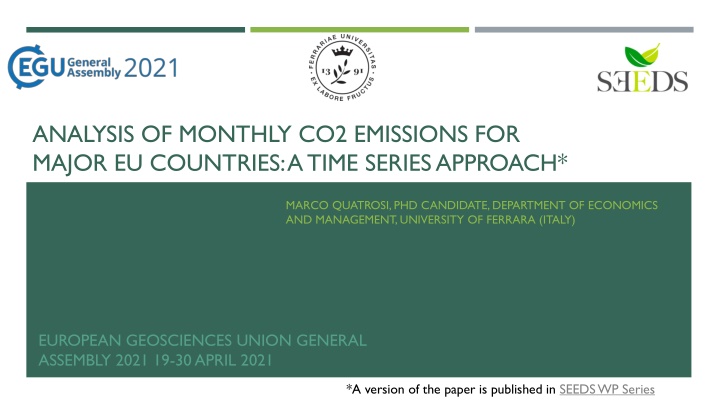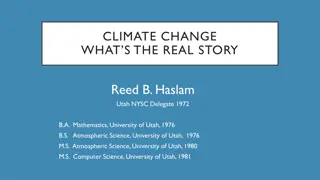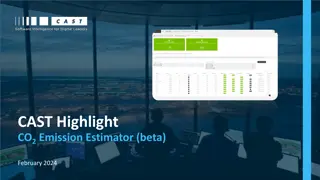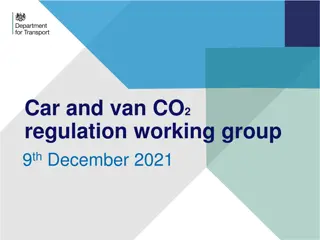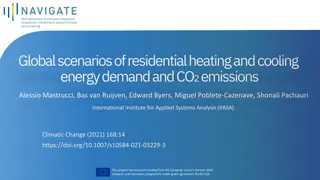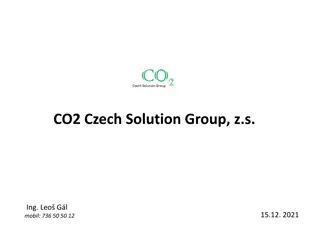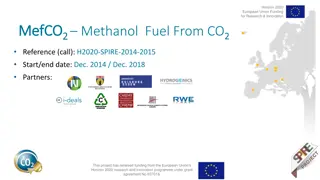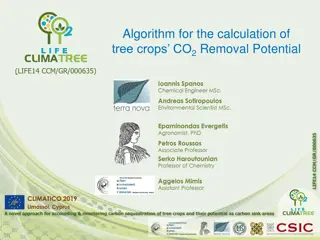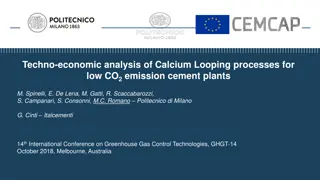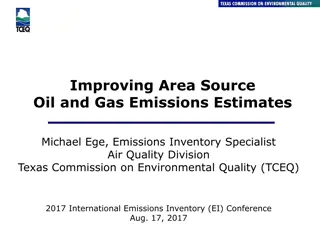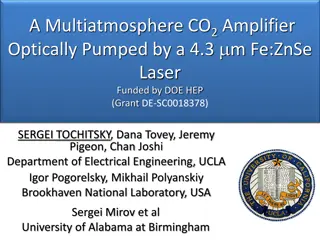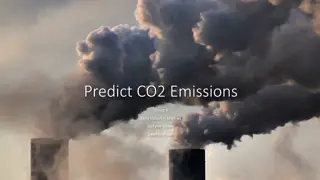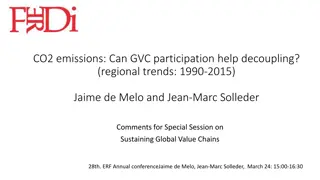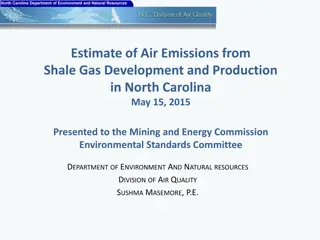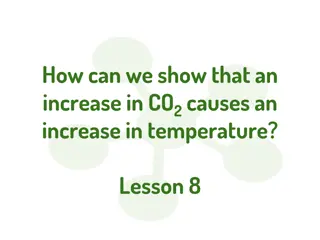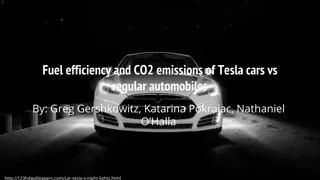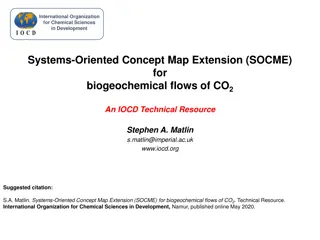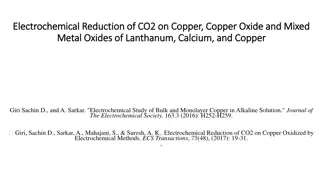Analysis of Monthly CO2 Emissions in EU Countries: A Time Series Approach
GHGs have significant impacts on global warming, with CO2 being the most abundant in the atmosphere. This study analyzes monthly CO2 emission trends in major EU countries using a time series approach, covering data from 2008 to 2019. The research delves into the methodology, estimated trends, and the implications for policy and environmental management.
Download Presentation

Please find below an Image/Link to download the presentation.
The content on the website is provided AS IS for your information and personal use only. It may not be sold, licensed, or shared on other websites without obtaining consent from the author.If you encounter any issues during the download, it is possible that the publisher has removed the file from their server.
You are allowed to download the files provided on this website for personal or commercial use, subject to the condition that they are used lawfully. All files are the property of their respective owners.
The content on the website is provided AS IS for your information and personal use only. It may not be sold, licensed, or shared on other websites without obtaining consent from the author.
E N D
Presentation Transcript
ANALYSIS OF MONTHLY CO2 EMISSIONS FOR MAJOR EU COUNTRIES: A TIME SERIESAPPROACH* MARCO QUATROSI, PHD CANDIDATE, DEPARTMENT OF ECONOMICS AND MANAGEMENT, UNIVERSITY OF FERRARA (ITALY) EUROPEAN GEOSCIENCES UNION GENERAL ASSEMBLY 2021 19-30 APRIL 2021 *A version of the paper is published in SEEDS WP Series
EXECUTIVE SUMMARY Introduction Data and methodology Analysis of the database Time series Results Conclusion EUROPEAN GEOSCIENCES UNION GENERAL ASSEMBLY 2021 19-30 APRIL 2021
INTRODUCTION GHGs have proved to be among the major causes of global warming with all the consequences on living and non-living organisms on the Planet (IPCC, 2018; Chaabouni et al., 2016; Rabl & Spadaro, 2000; Watts et al., 2018) CO2 the most present and abundant GHG in the atmosphere (40 Gt/yr in 2019 (PBL Netherland EnvironmentalAgency, 2020)) Fossil fuels (e.g., coal) still represent a significant source of energy production (IEA, 2019) The bulk of the data on emissions, only cover annual time span in line with the objectives set out at international level (Report of the Conference of the Parties on Its Nineteenth Session, Held in Warsaw from 11 to 23 November 2013, 2013) EUROPEAN GEOSCIENCES UNION GENERAL ASSEMBLY 2021 19-30 APRIL 2021
DATA AND METHODOLOGY Estimated monthly trends of CO2 emissions for 31 EU Countries (27 + United Kingdom, Norway, Iceland), 9 fossi fuels (4 primary, 5 secondary) from 2008 to 2019 Data on energy (e.g., Gross Inland Deliveries) from Eurostat, data on emission factors/carbon content UNFCCC Common Reporting Framework (country-specific) and IPCC Emission Factor Database EUROPEAN GEOSCIENCES UNION GENERAL ASSEMBLY 2021 19-30 APRIL 2021
DATA AND METHODOLOGY ??2 ????????? = ???? ?????????? ?????? 10 3 ???????? ?????????? ???????? ??????????????? ??????? 44/122 2006 IPCC Giudelines for National GHG Inventories Tier 1 (default), Tier 2 (country-specific), Tier 3 (industry-specific) EUROPEAN GEOSCIENCES UNION GENERAL ASSEMBLY 2021 19-30 APRIL 2021
DATA AND METHODOLOGY Example: Crude Oil-Austria- 2008 [(719 (th tonnes)*42,5(TJ/kt)*20(TJ/Gg))*10^-3-14,28)-1*44/122]= 215,2285 (th tonnes) Conv Factor Content Carbon Carbon Oxidation Factor EUROPEAN GEOSCIENCES UNION GENERAL ASSEMBLY 2021 19-30 APRIL 2021
DATA AND METHODOLOGY Fuel Category Type Time Hard Coal Primary fuel Solid 01/2008-11/2019 Lignite (Brown coal) Primary fuel Solid 01/2008-12/2019 Crude Oil Primary Fuel Liquid 01/2008-07/2019 Natural Gas Primary Fuel Liquid/Gaseous 01/2008-12/2019 Gas/Diesel Oil Secondary Fuel Liquid 01/2008-12/2019 LPG Secondary Fuel Liquid 01/2008-12/2019 Naphta Secondary Fuel Liquid 01/2008-12/2019 Petroleum Coke Secondary Fuel Liquid 01/2008-12/2019 Coke Oven Coke Secondary Fuel Solid 01/2008-12/2019 EUROPEAN GEOSCIENCES UNION GENERAL ASSEMBLY 2021 19-30 APRIL 2021
TRENDS OF CO2 EMISSIONS EUROPEAN GEOSCIENCES UNION GENERAL ASSEMBLY 2021 19-30 APRIL 2021
TIME SERIES: BREAKPOINTS EUROPEAN GEOSCIENCES UNION GENERAL ASSEMBLY 2021 19-30 APRIL 2021
TIME SERIES: MODEL SPECIFICATION ARIMA (1,0,0) with non-zero mean AR1 mean Coefficient 0.4279 28839.6 SE 0.1139 406.2799 sigma^2 estimated as 3754975: log likelihood=-592.31 AIC= 1190.62 AICc= 1191.01 BIC= 1197.19 Following the approach in (Hyndman and Khandakar, 2008) EUROPEAN GEOSCIENCES UNION GENERAL ASSEMBLY 2021 19-30 APRIL 2021
TIME SERIES: MODEL SPECIFICATION EUROPEAN GEOSCIENCES UNION GENERAL ASSEMBLY 2021 19-30 APRIL 2021
RESULTS Crude Oil (crude_oil) highest contributor of carbon dioxide emissions Lignite the second: mostly led by countries (e.g., Germany, Poland, Czech Republic) with high use of coal-soured power plants Substitution of coal with oil and natural gas for many countries (e.g., United Kingdom, Italy) (Capece, 2014; Cooper, 2020; Pearson and Watson, 2012) EUROPEAN GEOSCIENCES UNION GENERAL ASSEMBLY 2021 19-30 APRIL 2021
RESULTS ARIMA(1,0,0) preliminary approximation of the DGP for CO2 emissions (ADF test, Canova- Hansen test, ACF, PACF) Breakpoint analysis: December 2012: in 2013 European EmissionTrading Scheme enters its Phase III (more stringent measures) March 2018: imposition of tariffs on imports of steel and aluminium from the US (Baker and Swanson, 2018; Zurcher, 2018). Market Stability Reserve (in force 2019) EUROPEAN GEOSCIENCES UNION GENERAL ASSEMBLY 2021 19-30 APRIL 2021
CONCLUSIONS Presentation of one of the few dataset on monthly data on CO2 emissions and analysis of the trends for representative EU Countries Homogeneity in trends, different major source of emission. Progressive phase-out from coal overall in Europe (exceptions Germany, Poland, Czech Republic). Process started decades ago Preliminary assessment of the DGP of the CO2 emissions EUROPEAN GEOSCIENCES UNION GENERAL ASSEMBLY 2021 19-30 APRIL 2021
THANKS FOR YOURATTENTION E-MAIL: MARCO.QUATROSI@UNIFE.IT EUROPEAN GEOSCIENCES UNION GENERAL ASSEMBLY 2021 19-30 APRIL 2021
